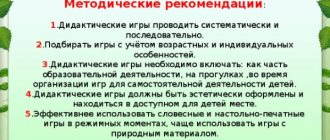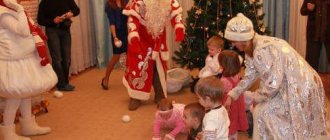ELVIRA TAGIROVA
Card index of environmental games
Ecological games in kindergarten are very important for developing young children’s understanding of the world around them, living and inanimate nature. They can bring considerable joy to children if the teacher takes care of a variety of games on an environmental theme . The specificity of environmental games for preschoolers is that the material conveyed to the child should not only be useful and educational, but also interesting. Therefore, it is best to involve children in active participation in the game to conduct environmental games for kids.
Didactic game “Whose traces”
Target. Development of visual analysis of images of objects in children.
Equipment. Drawings, photographs depicting animal tracks.
Progress of the game
From two to four children can take part in the game. The teacher suggests picking up two cards (animal tracks and the whole animal)
.
Children are given cards with a picture of an animal; they need to find traces of this animal. After completing the task, children can test themselves. To do this, you need to turn the cards back : if the color and shape of the figures on the back side match, then the combination of cards is assembled correctly . The one who correctly collects the largest number of combinations wins.
Didactic game “Find the shadow”
Goal: To teach children to find given silhouettes by overlapping.
Tasks:
-Develop cognitive activity.
-Develop children's visual perception, attention, and thinking.
-Develop visual superimposition techniques.
-Develop attentiveness, observation, memory and perseverance.
The role of environmental games in the education of preschool children
author: Guseva Irina Vladimirovna
Teacher MBDOU kindergarten No. 39
The role of environmental games in the education of preschool children
- Game as a method of environmental education
Environmental education is the unity of environmental consciousness and behavior harmonious with nature. The formation of environmental consciousness is influenced by environmental knowledge and beliefs.
The goal of environmental education is the formation of a responsible attitude towards the environment, which is built on the basis of environmental consciousness. This presupposes compliance with the moral and environmental principles of environmental management and the promotion of ideas for its optimization, active work in studying and protecting the nature of their area. The content of environmental education is absorbed by students in their various activities. Environmental games can be considered forms of education for environmental culture. Each form of organization of the educational process stimulates different types of cognitive activity of students: independent work with various sources of information allows you to accumulate factual material and reveal the essence of the problem; the game develops the experience of making appropriate decisions, creativity, and allows you to make a real contribution to the study and conservation of local ecosystems, and the promotion of valuable ideas. The essence of environmental games is that children, in direct contact with natural objects (observation or closer contact - touching a plant, animal, stroking a trunk, leaves, etc.), should tell something interesting about the natural object. These may be features of appearance, features of growth, development, care, or cases of careful (hard) attitude of people towards plants and animals. When conducting these games, it is necessary to take into account the following: - children should have a wide range of ideas about natural objects; - games are best played in a natural environment, so that children can approach a particular plant (animal), touch it, look at its condition (for the development of aesthetic, emotional perception of nature); - games of this block will give the best educational result if they are carried out with a small subgroup of children (5-7 children). Such an organization allows you to establish close emotional contact with children, call them to a frank conversation, gives all the children the opportunity to speak out, on the one hand, and on the other hand, it prevents fatigue and does not delay the progress of the game. It must be emphasized that these games especially enrich and expand the sphere of feelings and experiences, giving them meaning. With such mental activity associated with nature, an emotional impulse is born, indifference and indifference are completely eliminated - mental tension, creative thinking, and a passionate desire to learn more that are new, super interesting and unusual for oneself increase. A certain attitude towards nature as a whole and towards its specific object is created, attention to them intensifies, and, consequently, there is a process of emotional and psychological readiness to accept interesting and useful information about nature, i.e. a diverse interest in knowledge appears. The child becomes attentive to the natural world and everything that happens in it, takes the position of a protector and creator of beauty in nature. As a result, immediate emotional responsiveness is formed, the joy of upcoming knowledge, the excitement of meeting the unknown in nature, anticipation of unusual and wonderful encounters in this world, one’s strengths and abilities regarding the study of the surrounding nature. 2. Features of the ecological game
Ecological games are a form of environmental education and upbringing of ecological culture, based on the development of special play activities in children, stimulating a high level of motivation and interest in nature. The main tasks of the teacher when using an ecological game are as follows: - formation of a system of knowledge about nature; — formation of motives, needs, habits, environmentally appropriate behavior and activities in nature; — formation of communication skills. The technology for conducting an environmental game is as follows: 1. The teacher selects a section of the program and topics in which environmental games can be conducted. 2. Determines the place of the selected section and topic in the system of environmental education, highlights the basic concepts, ideas, and system of formative relationships. 3. Constructs the structure and course of the environmental game. 4. Defines a system of pedagogical conditions, built on the basis of the game method, ensuring the effective formation of environmental knowledge on the chosen topic. 5. Creates a system of tasks to check the starting level of knowledge and relationships, and conducts diagnostics. 6. Compiles a set of tasks to test the effectiveness of using the game method in educating the child’s environmental culture.
- Classification of environmental games.
According to the classification of S.L. Novoselova, all games, depending on whose initiative they arise (a child or an adult), are combined into three groups: 1) games that arise on the initiative of a child (or a group of children) - independent games (theatrical, experimental games, directing, plot-displaying, plot-role-playing); 2) games that arise on the initiative of an adult and older children - organized games (didactic, outdoor, leisure); 3) games that come from the historically established traditions of the people - folk games. Games with rules are of great developmental importance for preschoolers. In environmental education, games with rules provide an opportunity to present various natural phenomena obtained during observations and reading literature. Such games can play a big role in the development of various mental skills of preschoolers: the ability to analyze, compare, classify, and categorize.
3.1. didactic games.
Among the variety of games with rules for preschoolers, a special place belongs to didactic games. The name itself - didactic - suggests that the goal of these games is the mental development of children. Consequently, they are considered as a means of mental education of children. Based on the nature of the material used, didactic games are conventionally divided into games with objects, board-printed games and word games. Object games are games with folk didactic toys and various natural materials (leaves, seeds). These games contribute to the development of the child’s sensory skills, the formation of ideas about various sensory qualities (color, size, etc.). Board and printed games are aimed at clarifying ideas about the environment, systematizing knowledge, developing memory and thought processes. Printed board games include lotto, dominoes, cut pictures, folding cubes, etc. Verbal games develop attention, intelligence, speed of reaction, and coherent speech. Didactic games with environmental content expand children's understanding of the interaction between man and nature, the activities of people in nature, the relationships that exist in nature, contribute to the education of an emotional and value-based attitude towards nature, and the development of skills for a culture of behavior in the natural environment. Didactic games of an ecological nature include two relatively independent blocks: - games for the development of aesthetic perception of nature (development of a sense of beauty in nature, an emotional attitude towards it); — games for the formation of moral and evaluative experience of the behavior of preschool children in nature.
3.2. Role-playing game.
Role-playing game by its nature is a reflective activity.
The main source that fuels a child’s play is the world around him, the life and activities of adults and peers. Mastering knowledge about nature with the help of role-playing games that evoke an emotional response influences the formation of the correct attitude towards objects of the flora and fauna. The first stage of game management is the formation of the necessary range of knowledge about any aspect of reality, which serves as a source for constructing game plots. Next, through direct or indirect intervention, the adult teaches children to carry out play actions with objects and role-playing actions. The need to acquire knowledge about nature and master ways of implementing it in play combines play activities with environmental education. The inclusion of role-playing games in the learning process, in particular in ecology classes, in no way contradicts the formation of independent gaming activities. On the contrary, the implementation of program content by including various game elements into a lesson on the initiative of an adult will serve as a game model for children, a unique form of educational game, which will undoubtedly influence the content of subsequent games and the formation of the ability to independently implement game plans. The optimal form of including role-playing games in the process of introducing children to nature are game-based learning situations
(GES), which are created by the teacher to solve specific didactic problems of natural history classes and observations.
The main characteristic of the first type of IOS
is the use of analogue toys that depict various natural objects.
The toy helps to distinguish between ideas of a fairy-tale-toy and realistic nature, helps to understand the specifics of living things, and develop the ability to act correctly with a living object. The second type of ITS
is associated with the use of dolls depicting characters from literary works that are well known to children in order to arouse interest and attract children’s attention to the didactic goal of the lesson.
At the same time, it was discovered that the role of unknown game characters in training is extremely small: they mainly perform an entertainment function, and in some cases even interfere with solving the program tasks of the lesson. Meanwhile, the heroes of their favorite fairy tales and cartoons are perceived by children emotionally, excite the imagination, and become objects of imitation. This is indicated by many researchers who have studied the influence of literary works on the play of preschool children and their behavior. I.A. Komarova made the assumption that dolls - characters from some fairy tales, based on their literary biography, can be successfully used in natural history classes. For this purpose, Cippolino, Dunno, and Carlson were chosen. The third type of IOS
is various versions of the travel game: “Trip to an exhibition”, “Expedition to Africa”, “Excursion to the zoo”, “Journey to the sea”, etc. In all cases, this is a plot-based didactic game included in the lessons, observations, labor.
In each specific case, the plot of the game assumes the following: children visit new places, get acquainted with new phenomena and objects as excursionists, tourists, visitors, etc. As part of role-playing behavior, children examine and listen to explanations. The teacher, taking on the role of a tour guide, leader of a tourist group of an experienced traveler, etc., tells and shows the preschoolers everything new for which they set off on their journey. Ecological games make it possible to shift the emphasis from children’s assimilation of ready-made knowledge to an independent search for solutions to the proposed game problems, which contributes to mental education. The use of natural objects and their images in games creates a positive emotional background for the formation of children’s aesthetic feelings. Children's correlation of their actions in the natural environment with ethical standards presented in game tasks contributes to moral education. Awareness of oneself as a part of nature, a value-based attitude towards oneself, as well as towards other living organisms, promotes physical development. By mastering colors, their shades, the shape of objects, manipulating toys and other play equipment, and acquiring certain sensory experiences, children begin to understand the beauty of the world around them. Conclusion
Ecological games form a holistic vision of the world, lead to an awareness of one’s place and role in it, and teach one to independently understand the problems of the world around one.
The most popular types of environmental games in preschool age are role-playing games, didactic games, and games with rules. Investigating the effectiveness of using technologies for educating environmental culture, we found that it directly depends on the orientation towards the psycho-age characteristics of children, the specifics of their worldview and experience of interaction with the environment. The role of environmental games in the education of preschool children
Progress of the game:
Option 1. The teacher gives the children colored cards depicting various objects. Invites children to look at them. Next, the teacher shows a shadow (black and white)
any
picture . Children must find, among the available cards , the one that matches the desired silhouette and put a shadow on the picture .
Didactic game "Seasons"
for children 3–6 years old
"SEASONS"
Goal: to form children’s understanding of the alternation of seasons and some of their characteristics. Learn to establish cause-and-effect relationships between natural phenomena (season-vegetation-human labor)
. Expand your horizons.
Develop and activate your vocabulary.
Material: four cards depicting the seasons, cards depicting the characteristic features of each season.
Outdoor games in kindergarten with environmental content.
"The Falcon and the Fox"
Purpose of the game:
Expand children's knowledge about wild animals and birds of prey.
Ability to act quickly on a signal from a leader.
Progress of the game:
The teacher invites the children to play the game “Falcon and Fox”. Shows a picture of a falcon and talks about where this bird lives and how it behaves.
Remember the habits of a fox.
Choose a “falcon” and a fox according to the children’s wishes or use counting rhymes.
The rest of the children are “falcons”. The falcon teaches his falcons to fly. He easily runs in different directions and at the same time makes flying movements with his hands. A flock of falcon chicks runs after the falcon and exactly repeats its movements. At this time, a fox suddenly jumps out of the hole.
The falcons quickly squat down so that the fox does not notice them.
The appearance of the fox is determined by the leader's signal. The fox catches those who did not have time to sit down.
Bears and bees.
Purpose of the game:
Progress of the game:
The beehive (gymnastic wall or tower) is located on one side of the site. On the opposite side is a meadow. To the side is a den of bears. 12-15 people participate in the game at the same time. The players are divided into two unequal groups. Most of them are bees that live in the hive. Bears in a den. According to a conditioned signal, the bees fly out of the hive (get off the gymnastic wall), fly to the meadow for honey and buzz. As soon as the bees fly away, the bears run out of the den and climb into the hive (climb onto the wall) and feast on honey. As soon as the teacher gives the signal “Bears”, the bees fly to the hives, and the bears run away into the den. Those who do not have time to hide are stung by the bees (touched with their hands). Then the game resumes. Stung bears do not participate in the next game.
Directions.
After two repetitions, the children change roles. The teacher makes sure that the children do not jump, but climb down the stairs; if necessary, provide assistance.
Hunters and hares.
Purpose of the game:
Progress of the game:
On one side of the site a place for hunters is outlined. On the other side there are houses for hares. Each house contains 2-3 hares. The hunter walks around the area, pretending to be looking for tracks of hares, and then returns to his place. At a signal, the hares run out of their houses into the clearing and jump on two legs, moving forward. According to the teacher, “hunter!” the hares run into the houses, and the child, pretending to be a hunter, throws a ball at them. A hare that is hit with a ball is considered shot. The hunter takes him to his place. The game is repeated several times, after which another hunter is chosen.
Directions.
A hunter may have several balls in his hands. You cannot shoot hares in the houses.
Owl.
Purpose of the game:
Progress of the game:
An owl's nest is marked in one of the corners of the site. The driver in the nest is an owl. The rest of the players run around the playground, pretending to be beetles, butterflies and other insects. After a while, the teacher says: “Night.” The players freeze in place in the position in which the night found them. The owl flies out of its nest. It flies slowly, flaps its wings and looks to see if anyone will move. The one who moves is taken by the owl to her nest. And the teacher says: “Day.” Butterflies, beetles, etc. again begin to fly, spin, and buzz. After 2-3 flights of the owl to hunt, the number of those caught is counted. Another owl is chosen.
Progress of the game.
The game can be played by 4-8 people. The presenter shows one card depicting the characteristic features of each season. The player whose card this characteristic relates to describes and justifies this choice, lays out the card on the colored field .
Didactic game “Guess whose tail?”
(3-7 years)
Didactic tasks: consolidate knowledge on the topics “Wild and Domestic Animals”, create conditions for activating the child’s vocabulary on these topics, consolidate the ability to form possessive adjectives, develop the ability to analyze, consolidate the ability to distinguish and name animals, and develop fine motor skills of the hands.
Material: Animal images cardboard (silhouettes)
and tails glued to clothespins.






